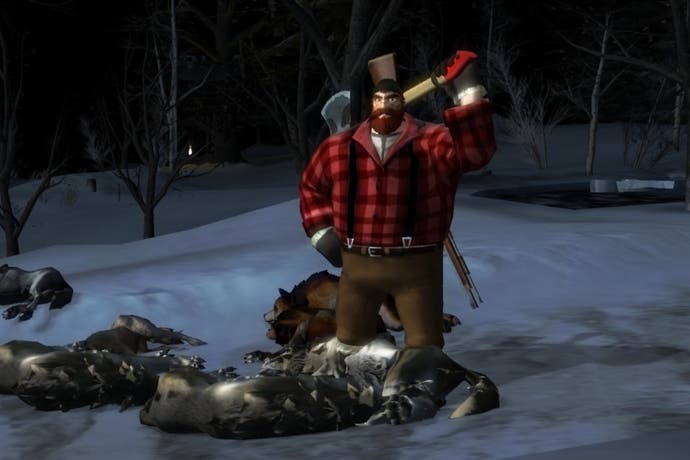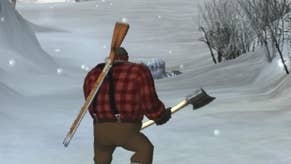Sang-Froid: Tales of Werewolves review
The cabin in the woods.
The 16th of December is All Trap Day, a vital date in the Canadian calendar, on which citizens take to the woods and defeat a variety of ungodly fiends using only hanging nets, spikes and those grinning spring-loaded clamps that come studded with sharp metal teeth. It's entirely possible that you haven't heard of this national holiday, of course, because I only invented it a week ago in a bid to make things even harder for myself. Still, I practise it religiously - practise being the operative word since, on the 16th of December, an all-trap approach doesn't really appear to be possible.
It's not possible for me, anyway, because I'm dangerously low on funds and I can't splurge on many of the deadlier gadgets on offer. I'd love to stick an explosive barrel over by the church, for example, baited to lure in the Maikan shamans and Maikan warrior when they nobly converge during the first wave. Meanwhile, the second Maikan warrior - the one on his way to the sawmill - is currently weakened by the scattering of cheap wolftraps I can afford, but he isn't comprehensively finished off by them. In a perfect world, I'd spring for some firewalls to herd him back to the church with the others - back to the church where I could theoretically blast him to pieces with that barrel that I don't have enough money to buy. But in Sang-Froid: Tales of Werewolves, even a perfect world won't really cut it.
Quite the Canadian pickle, in other words, and this is just one single wave of just one single night. The wider game delivers a whole month of brain-teasing and bloodshed as Artifice Studio takes the run-up to Christmas and transforms it. Gone are the cheerful bustle of last-minute shopping, the carollers calling and the tree being decked. Instead, you're in for sweaty terror and a lumpen-bellied sense of impending doom, punctuated by moments of hectic fighting as you protect your sister Josephine from a pack of encircling spirits who have decided to lay siege to your homestead to claim her.
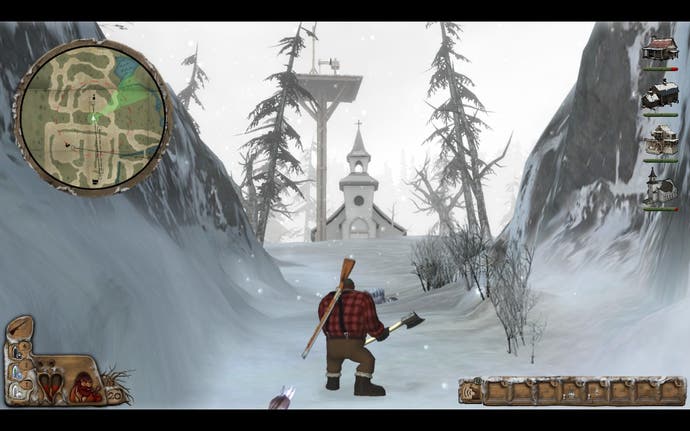
They're really determined, too, attacking afresh every evening, leaving you with the morning and afternoon to plan for them. Pick a brother (the thin one's hard mode, the fatty's a touch more forgiving) and then get to it, studying who you're up against next, staking out your traps, chopping wood to earn money, improving your tools, and then waiting for the moon to rise. Once it's dark, the action plays out in real time as you take to the fields on foot, moving from one hotspot to the next, leaning on the gadgets you placed earlier on, and seeing off as many baddies as you can before your feeble health gives out. The year is 1858 and the mood hovers somewhere between enervation and desperation. Happy holidays.
Stressful and ingenious, this is a wonderful basis for a hot-blooded strategy game. Its slight handicraft roughness aside, Sang-Froid really delivers, too. The remote 19th-century setting summons an almost palpable sense of isolation and helplessness, the religious preoccupations of the storyline lend everything a hint of the dark fable, while the complex design carves itself into neat little pieces, each of which brings its own pleasures and its own pains.
On the strategic level, Sang-Froid takes place across a top-down map of the small but ever-expanding territory that is yours to protect from the incoming nasties. From this perspective, you could be forgiven for thinking you're playing a simple tower defense game at first. Each day gives you all the time in the world to see who you're up against and which of your buildings they're targeting. Lose a single structure and it's game over - a bitter pill at the best of times, and that's before you realise that the wolves and monsters you're faced with like to divide and conquer.
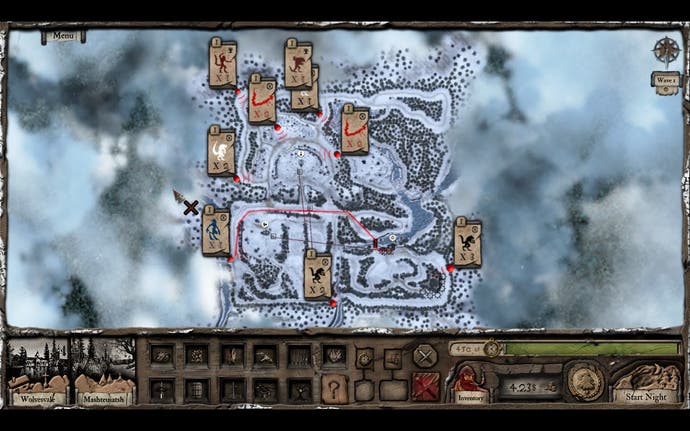
This is where the traps come in - paid for with your meagre earnings and placed around the map where you hope they'll be most effective. Each trap has its own quirks. The basic wolftrap is cheap but weak, for example. Spikes are better, but they require three monsters to stand on them before they're triggered. Hanging nets and explosive barrels are brilliant but you need to be lurking nearby to touch them off with a shot from your rifle. The Sacred Tree is a current favourite - a relatively late-game delight that zaps nearby miscreants and is powered up by standing underneath its boughs and doing a dance.
All traps eat money and time: money to buy them, time - in the form of action points - to lay them out before nightfall. Both resources are scarce, and if you run dry of either you're royally screwed. Adding extra strategic zing is the fact that you can trade action points for money by chopping wood instead of laying defences. It would be a neat idea in any game, but Sang-Froid's waves are so tautly constructed that these kinds of trade-offs really sting.
The strategy side of the thing's about getting your world sorted out in theory - this trap for that foe, this weapon for that potential outcome. When night falls and you head into the wilderness on foot, things get a lot more unpredictable. Plan meets reality. Cold design meets teeth and claws and the roots that clutch.
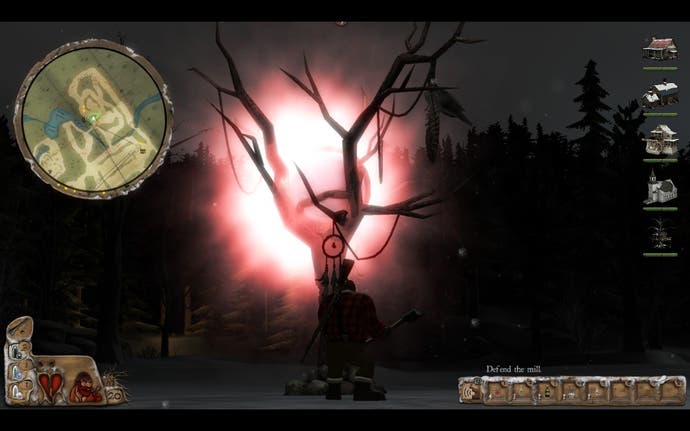
However well you've plotted during the day, Sang-Froid's real-time battles will provide a few surprises. You're always weak, for starters, tethered to a feeble stamina gauge that drains with every burst of sprinting and every swing of your axe. You can construct zipline towers to carry you around the map quicker, although they're vulnerable to attack themselves, and you can build up rage in fights to pull off special moves - but all-out slugfests against the forces of darkness are never your best bet in the first place.
Why rely on blunt melee combat when the AI's so interesting anyway? Sang-Froid's developers have done a dazzling job of capturing the pack instinct of these wolves and werewolves, and you should really make the most of it. Lone animals will stay back for a while before lunging at you - and they can be intimidated by bright lights or by shouting - but once a bunch of them gather, they'll attack with greater confidence. Visual indicators are simple and clear, but it's still truly astonishing to see dark forms circling you as you stand in the relative safety of a bonfire aura, frantically futzing with your rifle (it's more powerful than an axe, but it takes an absolute age to reload). Everywhere you look in Sang-Froid, from the threadbare textures to the wonky animation, you see a game created on a tight budget - that the team has delivered a foe possessed of true menace and true character is a real achievement.
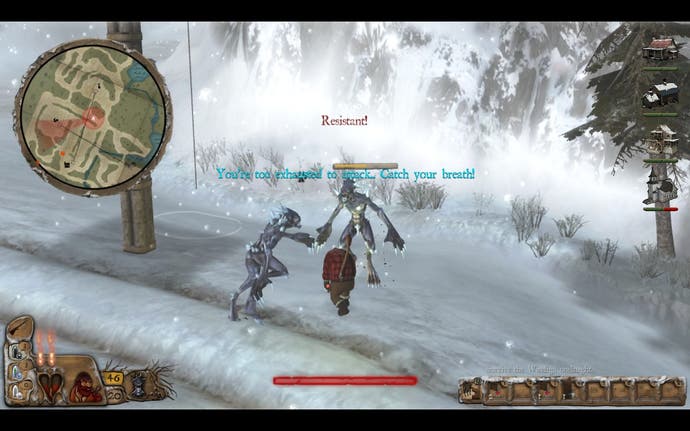
Speaking of foes, on top of standard wolves and werewolves, you'll face everything from will-o'-the-wisps, which are fiery little jerks who move around in swarms, to Maikan shapeshifters and the deadly frozen-breathed Windigos. The nastier the enemy, the more you'll rely on traps: you can draw baddies to you with a shout or by manipulating the wind and the direction in which it carries your scent, and a good Sang-Froid player understands the power of herding as much as wading in. This is a game built at the strange intersection of chilly strategic forward-planning and panicky, real-time tactics. It knows the energising pleasures of ad-libbing frantically when things go wrong, and despite all of the pressures put upon you - multiple foes making for multiple targets, a ranged weapon that is hard to aim - there's a real joy to be had racing about in the darkness and hearing a trap trigger in the distance. Got one! Now if I can just...
And so the map steadily opens out as new locations to defend are added. New monsters join the roster as the forces of darkness continue their siege on your cabin. Meanwhile, a nearby village and an indian reservation tempt you to part with money for potions, better gear, blessed weapons and even shaman trinkets that can boost your stats. Every improvement is hard-won, costly - and rather minimal. Even with a levelling system and a skill tree, this is a game that's been designed to make you feel exhausted. The payoff is that when it all goes well, you feel genuinely exhilarated in return. You feel an exhilaration I can't remember feeling in that many other games.
Buy Sang-Froid and you're paying for something rather peculiar, then: you're paying for a carefully-rigged fantasy of near-powerlessness, where your mind must win out over your failing body, over the harsh environment, and over odds that are lopsided in your enemy's favour. This is a strategy title that's open-ended enough to encourage creativity and rigorous enough to punish you when creativity fails.
Sure, all of this is coupled with ropy animation, hammy voice-acting and primitive art, and there are times when the challenge presented is so steep and unforgiving that you'll be dumped back to the start of the day with little desire to take all that punishment again. Eventually, though, you will head back in - lured by the richness, the strangeness and the sheer brain-teasing potential on offer. This is a rare game that feels like it was made because its creators simply had to execute on the idea, even if that meant they had to teach themselves how to do it. With that kind of foundation, it's more than worth the effort of teaching yourself how to play it properly.
